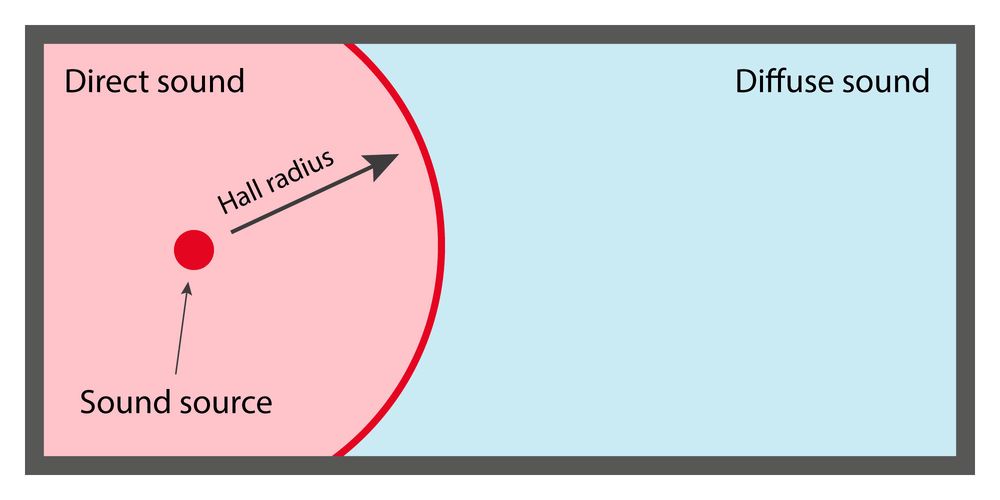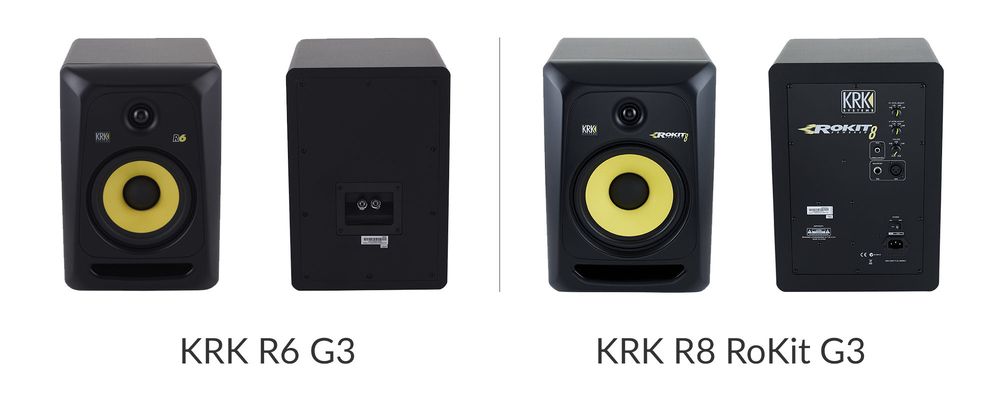3. Nearfield & Midfield
In this Online Guide, our primary focus is on "near-field monitors," as they are commonly used for monitoring audio during recording and studio mixing. To understand what sets near-field monitors apart from standard speaker boxes, let's explore some key terms first:
Monitor
The term "monitor" is derived from Latin and it means "to observe." As previously mentioned, the primary function of a studio monitor is to observe and accurately reproduce the sound of a recording and the subsequent processing.
Near-field
Each room, whether it's a control room, a recording space, or any other room, possesses unique acoustics that result from sound reflections. The acoustics can be influenced by walls, furniture, and the conditions of the surfaces in the room. Thus, acoustics in an untreated or acoustically unoptimized room can introduce unpredictable variables into the recording process, variables that should ideally be eliminated. However, since air's acoustic properties are consistent across different spaces, you should aim to locate a spot where reflections aren't audible. The point at which the direct sound and sound reflected by the room's surfaces have equal levels is referred to as the "critical distance" or "hall radius."


Inside the hall radius, you mainly hear direct sound, while outside it, reflected sound dominates. The actual size of this hall radius depends on the acoustics of the room and the directional characteristics of your speakers. In smaller rooms with intense sound reflections, the hall radius tends to be smaller. Additionally, the hall radius varies depending on the frequency being played because speakers don't treat all frequencies the same. They focus more on projecting high frequencies, but low frequencies tend to disperse in all directions. Consequently, the hall radius is more extensive for high-pitched sounds compared to lower frequencies. To extend the hall radius, you can enhance room acoustics by using absorbers and diffusers. Absorbers help reduce sound reflections, making their influence less prominent. On the other hand, diffusers scatter the remaining reflections in terms of space, time, and phase, which further reduces the effect of any remaining reverberations on the speaker playback.
The term "near-field monitor" is a bit misleading, as it has little to do with physical proximity. In fact, "near-field" and "far-field" are concepts related to the sound field produced by a speaker, and they're independent of room acoustics. These terms originate from technical acoustics, and while they are relevant in the field, they might not be the primary concern for sound engineers. A more precise description for these speakers would be "free-field" or "direct-field monitors" since they work best when sound directly radiates from the speakers and not influenced by room acoustics. However, the terminology of "near-field monitor" has prevailed over the years, so we will stick with the term "near-field monitor."

The concept behind near-field monitors is to position the listening area as close as possible to the direct sound field, essentially within the hall radius. This minimizes the impact of room acoustics on the sound. In the high- and mid-frequency ranges, this approach works quite well, as discussed earlier. However, in the low-frequency range, the hall radius in typical rooms is relatively small due to the omnidirectional nature of bass sound. This makes it almost impossible to have a listening area within the hall radius for bass frequencies. As a result, room influences, like resonances, become more pronounced, especially if the room hasn't been acoustically treated for bass frequencies. Due to the close listening position, near-field monitors are typically compact in size. They are often designed as bass-reflex speakers with woofers ranging from 4.5" to 8". Because of their small cabinet volume and woofer size, near-field monitors have limited bass reproduction compared to larger main monitors. In most cases, the frequency range of 8" monitors with bass reflex ports is sufficient for typical applications.
In terms of construction and design, near-field monitors differ little from hi-fi loudspeakers. The distinction lies more in the intended sonic performance. Hi-fi speakers are primarily crafted to deliver an aesthetically pleasing listening experience, often characterized by gentle highs and robust bass, ideal for music enjoyment. In the studio, a different sonic philosophy is required. The emphasis isn't on creating beautiful sound but rather on faithfully reproducing audio during recording and mixing. Sound engineers must accurately assess the quality of recorded and mixed signals. The goal is for the sound to be unaltered and truthful. Studio monitors are designed for sonic neutrality, striving for transparency in audio reproduction. Transparency ensures that the sound signal remains unchanged throughout playback, much like a clear glass window, in contrast to ornamental glass that distorts the view, losing details and retaining only the outlines. Transparency in audio means unaltered sound reproduction.
Today, near-field monitors are predominantly active, with passive speakers becoming increasingly rare. But what sets these two apart?
Passive speakers don't come with built-in amplification; they rely on an external amplifier to function. In a passive speaker system, the crossover, responsible for dividing the audio signal between the tweeter and woofer, is positioned within the signal path just before reaching the drivers. The crossover must be engineered to manage the high signal currents delivered by the external amplifier, which can make its design complex and relatively costly. Even though it primarily comprises coils and capacitors, designing an effective crossover without compromising sound quality is no small feat. This complexity of the crossover contributes to the preference for active (self-amplified) monitors in many modern audio setups.
Active speakers are designed differently. In an active speaker setup, the crossover is positioned before the power amplifier stage, which means it's exposed to significantly lower signal powers. This placement allows the crossover to be built using active amplifier components that are now more affordable. Active filters for crossovers can better manage phase issues at the crossover frequency. In active speakers, each driver has its dedicated power amplifier. This setup enables the manufacturer to optimize the crossover, power amplifier, and drivers to work in harmony. In contrast, when dealing with passive speakers, at least the amplifier remains an unknown variable for the manufacturer. The use of active components in this design generally reduces costs and enables manufacturers to create higher-quality speakers.





